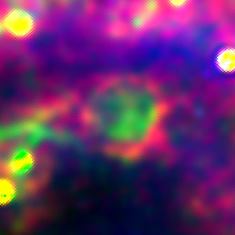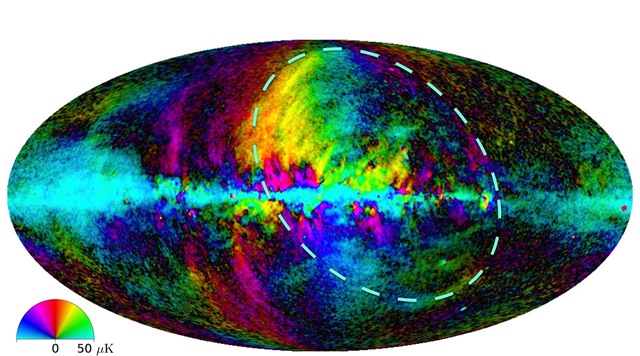Rings and Loops in the stars: Planck's stunning new images
6 Jul 2015

An image of the ring around the star Lambda Orionis, made with the ESA Planck satellite. The ring, here seen in pink, is around 200 light years across. In the image red represents the anomalous microwave emission (AME), green represents the emission from interstellar plasma and the blue is emission arising from electrons moving in magnetic fields. Credit: M. Peel / JCBA / Planck / ESA. Click for a full size image
A ring of dust 200 light years across and a loop covering a third of the sky: two of the results in a new map from the Planck satellite. Dr Mike Peel and Dr Paddy Leahy of the Jodrell Bank Centre for Astrophysics (JCBA) presented the images today at the National Astronomy Meeting (NAM 2015) at Venue Cymru, Llandudno, Wales.
The European Space Agency (ESA) Planck satellite, launched in 2009 to study the ancient light of the Big Bang, has also given us maps of our own Galaxy, the Milky Way, in microwaves (radiation at cm- to mm-wavelengths). Microwaves are generated by electrons spiralling in the Galaxy's magnetic field at nearly the speed of light (the synchrotron process); by collisions in interstellar plasma, by thermal vibration of interstellar dust grains, and by "anomalous" microwave emission (AME), which may be from spinning dust grains.
The relative strength of these processes changes with wavelength, and are separated using multi-wavelength measurements from Planck, from NASA's WMAP satellite, and from ground-based radio telescopes, giving maps of each component.
The new maps show regions covering huge areas of our sky that produce AME; this process, only discovered in 1997, could account for a large amount of galactic microwave emission with a wavelength near 1 cm. One example where it is exceptionally bright is the 200 light year-wide dust ring around the Lambda Orionis nebula (the 'head' of the familiar Orion constellation). This is the first time the ring has been seen in this way.
A wide field map also shows synchrotron loops and spurs (where charged particles spiral around magnetic fields), including the huge Loop 1, discovered more than 50 years ago. Remarkably, astronomers are still very uncertain about its distance - it could be anywhere between 400 and 25,000 light years away - and though it covers around a third of the sky it is impossible to say exactly how big it is.
The new work has been submitted to "Planck 2015 results. XXV. Diffuse low-frequency Galactic foregrounds", the Planck Collaboration, Astronomy and Astrophysics. See the preprint of this paper. This research was supported by an ERC Starting (Consolidator) Grant (no. 307209) and STFC Consolidated Grant (no. ST/L000768/1).

A full sky map made using the ESA Planck satellite. Loop 1, marked by the dashed ellipse, is the yellow feature above centre, shading to purple, and the purple arc below centre. The colours represent the angle of the magnetic field and the brightness represents the signal strength. Credit: P. Leahy / JCBA / Planck / ESA. Click for a full size image.
Notes for editors
The Royal Astronomical Society National Astronomy Meeting (NAM 2015) will take place in Llandudno, Wales, from 5-9 July. NAM 2015 will be held in conjunction with the annual meetings of the UK Solar Physics (UKSP) and Magnetosphere Ionosphere Solar-Terrestrial physics (MIST) groups. The conference is principally sponsored by the Royal Astronomical Society (RAS) and the Science and Technology Facilities Council (STFC).
The Royal Astronomical Society (RAS), founded in 1820, encourages and promotes the study of astronomy, solar-system science, geophysics and closely related branches of science. The RAS organises scientific meetings, publishes international research and review journals, recognizes outstanding achievements by the award of medals and prizes, maintains an extensive library, supports education through grants and outreach activities and represents UK astronomy nationally and internationally. Its more than 3800 members (Fellows), a third based overseas, include scientific researchers in universities, observatories and laboratories as well as historians of astronomy and others.
The Science and Technology Facilities Council (STFC) is keeping the UK at the forefront of international science and tackling some of the most significant challenges facing society such as meeting our future energy needs, monitoring and understanding climate change, and global security. The Council has a broad science portfolio and works with the academic and industrial communities to share its expertise in materials science, space and ground-based astronomy technologies, laser science, microelectronics, wafer scale manufacturing, particle and nuclear physics, alternative energy production, radio communications and radar. It enables UK researchers to access leading international science facilities for example in the area of astronomy, the European Southern Observatory.
Jodrell Bank Centre for Astrophysics (JBCA) is directly involved with the two lowest frequencies of the Low Frequency Instrument, the 30 and 44 GHz radiometers. These have 4 and 6 detectors respectively, operating at 20K (-253.15°C or -423.67°F). The resolution on the sky is 33 and 27 arc minutes, and the sensitivity 1.6 and 2.4 micro K (over 12 months). The cryogenic low noise amplifiers which are the heart of the radiometers were developed at Jodrell Bank, with help from the National Radio Astronomy Observatory in Virginia, USA.
The work to understand the Galactic emission seen by Planck is being co-led from Jodrell Bank by Emeritus Profs Rod Davies and Clive Dickinson. A number of projects are led by Jodrell Bank scientists, including Profs Richard Davis and Clive Dickinson. Each of the 14 projects focusses on one aspect of the Galaxy as seen by Planck, including the electrons that gyrate in the Galactic magnetic field, the ionized gas that pervades the interstellar medium and the dust grains that emit across the entire frequency range that Planck is sensitive to. Jodrell Bank is also leading the calibration and identifying systematics in the LFI data.
Media enquiries
Robert Massey
Royal Astronomical Society
Mob: +44 (0)794 124 8035
Ms Anita Heward
Royal Astronomical Society
Mob: +44 (0)7756 034 243
Dr Sam Lindsay
Royal Astronomical Society
Mob: +44 (0) 7957 566 861
Dr Mike Peel
Jodrell Bank Centre for Astrophysics
michael.peel@manchester.ac.uk
Dr Paddy Leahy
Jodrell Bank Centre for Astrophysics
j.p.leahy@manchester.ac.uk
Prof Clive Dickinson
Jodrell Bank Centre for Astrophysics
clive.dickinson@manchester.ac.uk


